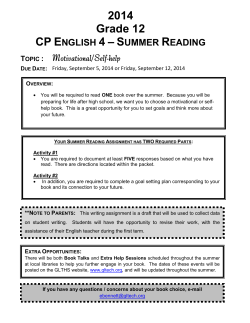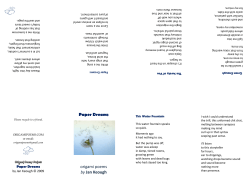
Magazine
Magazine For children, parents and for teaching purposes Free to take home Issue 2015 Make your own dream catcher Take part in the colouring competition An initiative from www.world-kids-colouring-day.com.au in support of in support of Colourful DREAMS to colour in World Kids Colouring Day 2015 y? What is World Kids ColouringulgDa e your n you can ind On this global day of actio need. For many years creative side to help kids in ring Day, kids around now on World Kids Colou ring bright and cheerful the globe have been colou s. This time the topic is pictures on a variety of theme y our sleep at night. Join the dreams that accompan lourful world of dreams us on our journey into the co wild! and let your imagination run Donate! Donations can be deposited to the donation account specially set up for this event. Save the Children Fund, BSB: 062 000 Account number: 1275 7357 Or you can send a bank cheque to: Save the Children Fund, C/- STAEDTLER (Pacific) Pty Ltd, Level 3, 18 Aquatic Drive, Frenchs Forest NSW 2086. WORLD KIDS COLOURING DAY 2015…………… P. 2 WHY DO WE DREAM?…………………………… P. 3 MARSY DREAMS………………………………… P. 4-5 DREAM CATCHERS……………………………… P. 6 MODELLING A SANDMAN……………………… P. 7 DREAM PUZZLE………………………………… P. 8 - 9 COLOURING WORKSHOP………………………… P. 10 COLOURING TEMPLATE………………………… P. 11 2 How can you take part? If you are taking part with your school class or your kindergarten, ask your teacher to register on www.world-kids-colouring-day.com.au to receive a free group supporter pack. You can also ask your parents to register if you want to be part of it just by yourself! Then, create a picture story around the theme ‘colourful dreams’, find a sponsor and send your art directly to: STAEDTLER (Pacific) Pty Ltd, World Kids Colouring Day, Level 3, 18 Aquatic Drive, Frenchs Forest, NSW, 2086. Scan and upload your image to our Facebook page (www.facebook.com/ STAEDTLERAustralia) or email to: contact@world-kids-colouring-day.com.au Terms & conditions for entry and the prize. Little artists have until 1st June 2015 to send in their pictures. The prize for the most creative group entry is a $1,000 cash grant and a STAEDTLER prize pack valued at $500. The most imaginative individual entry will receive a great STAEDTLER prize pack valued at $200. You’ll find the entry terms & conditions at: www.world-kids-colouring-day.com.au Why do we dream? Everyone dreams at night but we don’t always remember our dreams upon waking. Sometimes we’re quite happy about that – if for example we’ve had a nightmare or falling dream. Still, dreams can be really lovely - about wonderful places, animals or much loved people. It’s difficult to say exactly why we dream. Some scientists suggest that dreams help us process what has happened during the day. Of course, Mars, Marsy and Siggi dream too! On the following pages you can immerse yourselves in their dreams and even help create them. How many frogs is Mars dreaming about? Copy Siggi’s dream line really carefully! Marsy’s dream castle needs colour, windows and doors! 3 Marsy DREAMS … I ’m t a l ki n g to a c ro c o di le o n t h e st re e t I’ lim mc bi n g a l o n g st a i rc a se u p in to he t clo u ds Fro he mt steps I ’ m fly i n g to a c ro o ke d to w er ng a bov e the clo u ds o na g ia n tc T he ’ nI idi mr at Sudden ly I ’ mb ng ei fo l lowed m by a t r u l y s c a r y Marsy has a really wild dream. Read the sentences about the different dream pictures carefully. In her dream there are lots of dream symbols that you might recognise from your own dreams. Dream symbols often represent events that have something to do with real life. Interpreting them can sometimes help to solve problems. 4 o n ster Cat: the cat is a symbol for luck and wisdom. It stands for independence and self-reliance. Its soft fur has to do with comfort and safety. Crocodile: the crocodile or any other reptile is usually a rather frightening dream symbol. It often mirrors our fears or things that threaten us and doesn’t usually occur in friendly dreams. c ap e by a s a i l i n g b o at, bi g, b r i g ht ly t h a g re c olo u re df is h at Wh e n I w a ke up, I ’ m l ng s m wi ng mi he in t er wi w at ca n es yi in I ’m Lu yI c ki l am e ado w fil le d w i t h t re e s Flying: this is different from falling dreams which What’s next? often have to do with fears; dreams of flying are mostly Marsy goes on dreaming ... but wait a minute, in the pleasant. Flying dreams mean freedom and are likely to be last three dream pictures there are some important parts missing. Read the sentences carefully and finish colouring good dreams. Monsters: monsters as they appear in our the pictures as described! dreams are mostly big and scary. They may mean there are things we are worried about. Sometimes we also dream about monsters we know from cartoons or films. 5 Dream catchers What is a dream catcher? You need: Hoop made of wood, metal or plastic Wool or tape String Feathers Small wooden beads and larger ones Blunt needle Hobby scissors Glue Native Americans used to believe in the magical beings and powers that we meet in our dreams. To make sure their children slept well and safely they constructed dream catchers. These were supposed to catch the bad dreams in a net while letting the good dreams through. Only the good dreams would glide down to their children via the threads and feathers. 1. Wrap the wool or tape thickly around the hoop so that you can no longer see the wood, metal or plastic. Knot it at both ends and leave enough thread so that later you can hang your dream catcher up by it. 2. Tie the end of the string to your chosen place on the hoop. Thread the other end through the eye of a blunt needle. Guide the needle with the string along the hoop and leaving a distance of a few centimetres each time, wrap the string backwards over the hoop. Then pull the string from behind to the front through the loop thus formed. A knot is formed which prevents the loop from slipping. 3. Fix six more loops to the hoop as just described, making sure they are evenly spaced. The seventh loop should be a half to a whole loop width from the start. It takes practice to get evenly spaced distances. 4. As soon as the distances are equal you can start with the second row of your net. Continue as you did for the first row. You are not tying the loops to the hoop now, but to the string – always in the middle between the two knots in the first row. 5. From the third row onwards thread one of the smaller wooden beads every now and then between the loops. Do as many rows as you need to get to the middle of the net. There you can thread on a thicker wooden bead and knot it in such a way that it can’t be seen. Then cut the end of the string. 6. Cut three equal length threads from the string. Make a knot at the end of each length of string and thread the rest of the beads on to them. Stick two feathers into the lowest bead. Add a drop of glue so that the feathers stick to the beads. Now you need to tie the three lengths of string with the beads and feathers on to the hoop and your dream catcher is complete. Sweet dreams! 6 Modelling a sandman You need: • FIMO kids blocks in red, white, black, flesh and glitter gold • Cutting tool or a small knife • A grown-up to help you Body Arms Arms Preparation Head First model the sandman‘s body and arms plus the head, hands and feet. You will see how much FIMO you need for the different body parts from the instructions on this page. Feet Hands Cap Roll out the FIMO and cut out two cap shapes with your cutting tool or knife. Let a grown-up help you with this! Place both parts together so that underneath there is a hole for the head. Lastly shape the pointed tip. Sack Use FIMO kids glitter gold Beard & hair Roll out three thin pointed pieces for each of these and bunch them together. If you want to you can also decorate the sandman – for example with buttons in glitter gold. to model a thick cone shape, then stretch and push it in until you have the sack shape you want. Putting it all together You can now put the modelled parts together to form your sandman. First stick the hair and beard onto the head and then the cap. Join the hand and sack and then the hands and arms. Carve on the eyes, mouth and nose. Ask a grown up to help you with this and with the hardening too! Your sandman needs 30 minutes in the oven at 110 degrees. 7 Dream puzzle Colouring Colour in the trees with bright colours! D A B R E F P L E M S T E Finding your way A N K Follow the correct letters through the letter maze to find the word “dream dancer”. Colour the pathway with bright colours! 8 I H M D J G Calculate the numbers pile from bottom to top and then top to bottom! E A O Calculate A Z E R C U W Organising Q There’s a lot going on here in the meadow. Tidy it by circling all the animals in red, the objects in blue and the plants in green. ^ Colour key: Colouring in Colour in the patterned areas on the hill with the correct colours. Use the colour key to guide you. , , , and patterns Now use the key to colour the balloons with the correct patterns. = = = = = 9 Colouring workshop Dream pictures with fibre-tip pens, watercolours and water 1. Fibre-tip pens & watercolours Think up a nice simple subject and draw it on watercolour paper with fibre-tip pens. If you don’t have any watercolour paper you can use blotting paper. The edges run and colours become more delicate. If you want to avoid the colours running one into the other, let it dry first before putting on another area of colour. 2. Fibre-tip pens & drips of water You can get interesting effects using water-soluble fibretip pens and drips of water. With patience and a steady hand you can apply the drips precisely and to good effect. Here too you get the best results if you use watercolour or blotting paper. Only allow a couple of drips of water on to the paper and wait until dry. Then the colours will run a bit at a time and you can control the outcome more easily. 3. Fibre-tip pens & water Draw something bright and colourful on watercolour paper with fibre-tip pens! Run over it with a wet brush and see how the colours mix. Watch closely and you’ll see how the colours run when mixed with water and which new colours emerge. 10 World-kids-colouring-day 2014 Review Stories In 2014, as in previous years, STAEDTLER encouraged kids to take part in its seventh international World Kids Colouring Day. The theme was “a colourful world trip”; kids across the globe were challenged to draw and colour pictures to express their own ideas about life in other countries or get their especially good holiday memories down on paper. And at the same time, these young artists were supporting children in need: their commitment meant that once again funds were raised across the world to help a large number of aid projects. in support of STAEDTLER is one of the leading international manufacturers of writing, colouring and drawing instruments. Founded in Nuremberg, Germany in 1835, the company’s international headquarters is still situated there today. Globally, STAEDTLER employs over 2,200 staff in more than 150 countries. In Australia, STAEDTLER’s head office is located in Frenchs Forest, Sydney. STAEDTLER‘s philosophy of ‘a brand with tradition shaping its future’ describes both the origin and dedication of the company. Quality, innovation, design and functionality characterise all STAEDTLER products. STAEDTLER has supported many children‘s projects over the years and is proud to be the initiator for the ongoing World Kids Colouring Day on the 6th of May every year to help more children in need. More info at www.staedtler.com.au Save the Children is one of Australia’s largest aid and development agencies dedicated to helping children. They protect and support children in need, save lives in emergencies and speak up for children’s rights. With the collected donations from World Kids Colouring Day, STAEDTLER will support Save the Children’s Australia programs. Some key statistics about why Save the Children works in Australia: • Indigenous children are more than twice as likely to be developmentally vulnerable on the Australian Early Development Index than non-indigenous children. •Around half of Australian 4-5 year olds attended preschool in 2012, making Australia one of the OECD countries with the lowest preschool attendance What Save the Children is doing to change this: • Currently reaching around 30,000 children, young people and parents here in Australia. • Around 50% of the programs focus on improving the lives of Aboriginal and Torres Strait Islander children, young people and their families. • Save the Children’s Early Childhood Programs directly reach 9,000 children and 6,500 parents across around 100 sites. Together we will continue to save and protect children’s lives and strive to give every child a safe and happy childhood. More info at www.savethechildren.org.au Photo: Jim Holmes Save the Children Australia For more information on these and other STAEDTLER products refer to our website or contact customer service. Phone: 1300 366 555 Fax: 1300 366 444 www.staedtler.com.au /STAEDTLERAustralia 0I870G6000
© Copyright 2025









